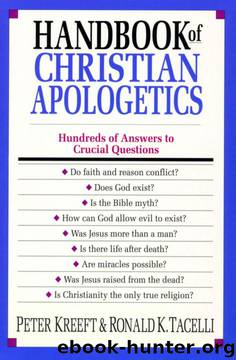Handbook of Christian Apologetics by Peter Kreeft & Ronald K. Tacelli

Author:Peter Kreeft & Ronald K. Tacelli [Kreeft, Peter & Tacelli, Ronald K.]
Language: eng
Format: epub, mobi
Tags: Religion, Christian, Spirituality, Philosophy, Reference, Non-Fiction
ISBN: 9780830817740
Goodreads: 883436
Publisher: IVP Academic
Published: 1994-03-22T00:00:00+00:00
Know When to Interpret the Bible Literally vs. Symbolically
Modernists often interpret "turn the other cheek" literally and embrace pacifism, but interpret the miracles symbolically and embrace naturalism. Why? Fundamentalists often interpret the "days" of creation literally and reject evolution, but interpret "This is my body" symbolically and reject the notion of the real presence in the Eucharist. Why? Are there any consistent and objective guidelines for literal versus symbolic interpretation?
The first and simplest answer is this: When the biblical author claims he saw something in the external world with his own eyes, or that someone else did and told him, then we are to interpret it literally. (Remember, we must distinguish interpretation from belief; to say we must interpret it literally is not to say we must believe it.) On the other hand, when a thing is not visible to the eye, we cannot interpret it literally. Here are three such cases.
1. Sometimes the object in question is by its nature invisible, like God or the soul.
2. Sometimes the author claims to have "seen" it only with the inner eye, in a vision or a dream.
3. And sometimes the author "made it up"; it is fiction, like a parable.
The line between literal and nonliteral is not simply the line between natural and supernatural, or miraculous. For one thing, miracles are visible, not invisible, at least in their effects, though not in their causes. For another thing, the natural-or-supernatural criterion is an external criterion taken from philosophy or theology, not an internal criterion taken from the form of the text itself.
We find important examples of symbolic language in the Bible's first and last books: the first three chapters of Genesis and the last eighteen chapters of Revelation. We find important examples of literal language in the miracle stories in both Old and New Testaments. But both fundamentalists and modernists seem prone to violate this simple guideline here, for theological rather than textual reasons. Fundamentalists have theological reasons for not wanting to interpret Genesis symbolically, and modernists have theological reasons for not wanting to interpret miracles literally. But these are both criteria of belief, not interpretation.
Another point both sides ignore or deny is that a given passage could be rightly interpreted both literally and symbolically. (See Aquinas's quotation on page 210.) For instance the church fathers often interpreted the exodus symbolically. The children of Israel symbolized the church, Moses symbolized Christ, the Red Sea symbolized death, the Promised Land symbolized heaven, the wilderness symbolized purgatory, Egypt symbolized the world, Pharaoh symbolized the Devil (Jesus calls him "the ruler of this world," in Jn 12:31; 14:30; and 16:11). But they also believed it really hap pened. They were signs, and a sign must first stand there in the real world, literally, in order for it to have a second meaning in what it points to beyond itself.
For some strange reason, both sides seem reluctant to see the dimensions of interpretation the other side sees. For instance, most fundamentalists (and also many traditionalists who
Download
Handbook of Christian Apologetics by Peter Kreeft & Ronald K. Tacelli.mobi
This site does not store any files on its server. We only index and link to content provided by other sites. Please contact the content providers to delete copyright contents if any and email us, we'll remove relevant links or contents immediately.
Signature in the Cell: DNA and the Evidence for Intelligent Design by Stephen C. Meyer(2879)
Real Sex by Lauren F. Winner(2869)
The Holy Spirit by Billy Graham(2779)
The Secret Power of Speaking God's Word by Joyce Meyer(2755)
The Gnostic Gospels by Pagels Elaine(2400)
Jesus by Paul Johnson(2230)
Devil, The by Almond Philip C(2206)
23:27 by H. L. Roberts(2144)
The Nativity by Geza Vermes(2117)
Chosen by God by R. C. Sproul(2056)
All Things New by John Eldredge(2052)
Angels of God: The Bible, the Church and the Heavenly Hosts by Mike Aquilina(1870)
Angels by Billy Graham(1844)
The Return of the Gods by Erich von Daniken(1842)
Knowing God by J.I. Packer(1724)
Jesus of Nazareth by Joseph Ratzinger(1709)
Evidence of the Afterlife by Jeffrey Long(1705)
The Gnostic Gospel of St. Thomas by Tau Malachi(1681)
How To Be Born Again by Billy Graham(1670)
